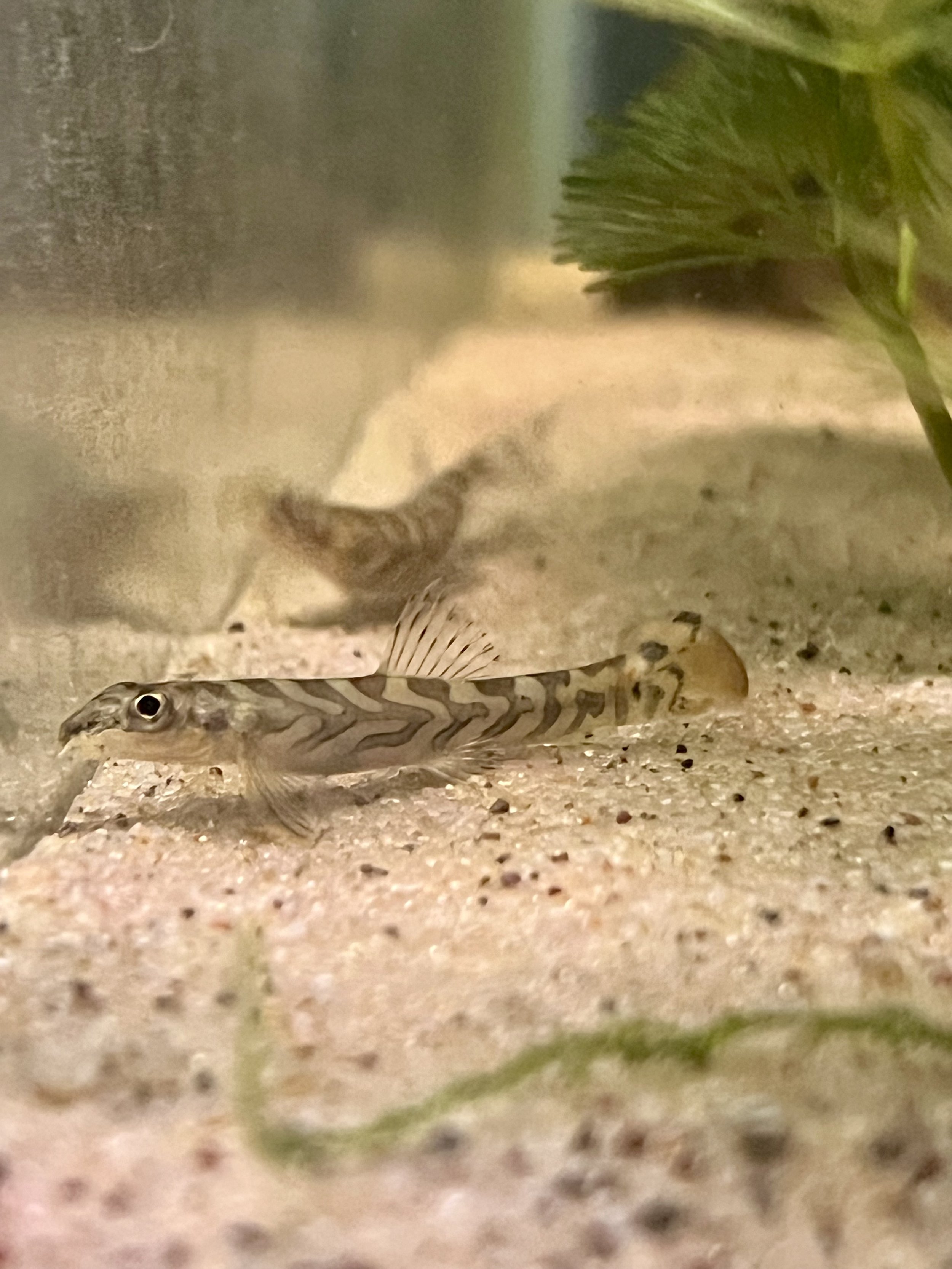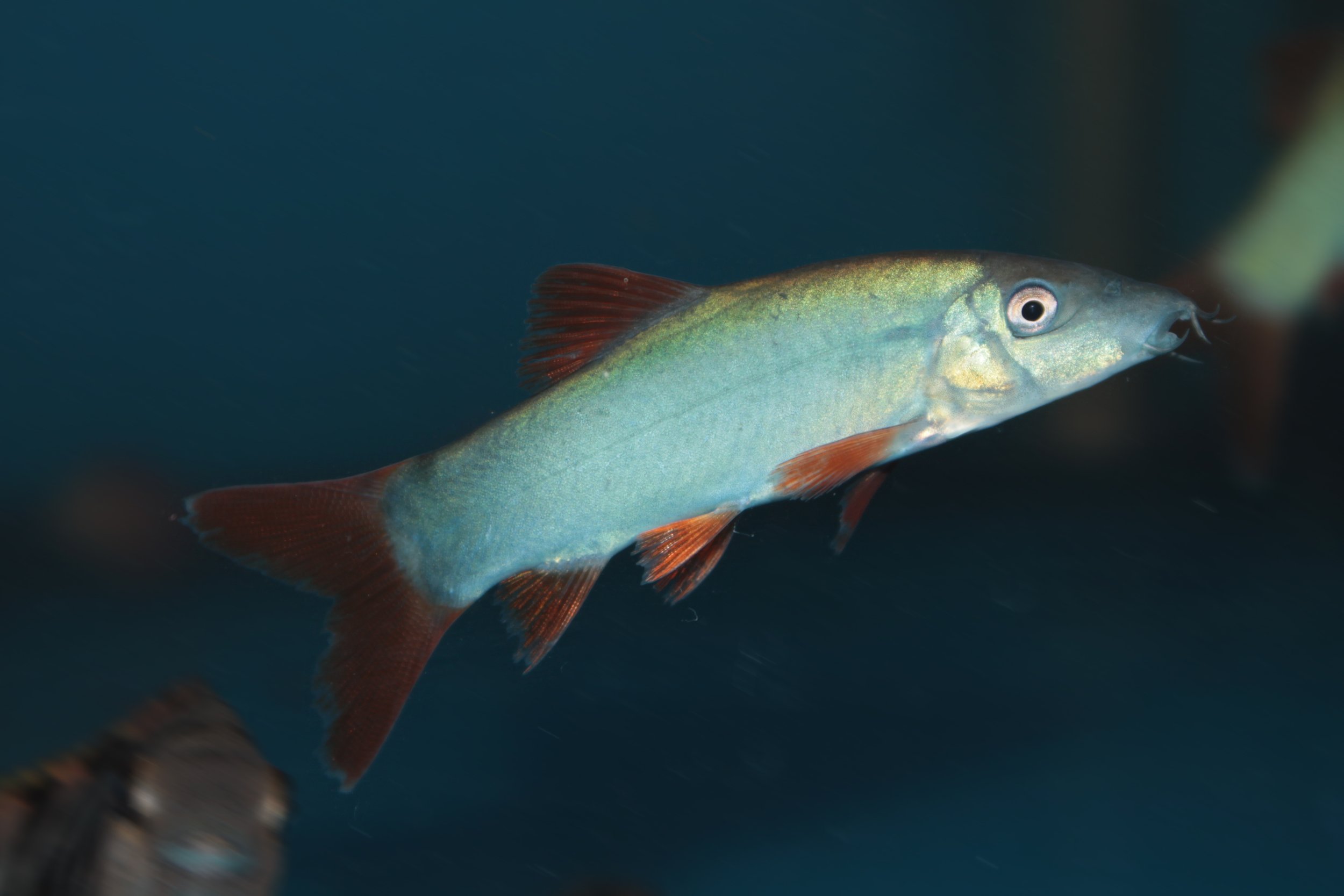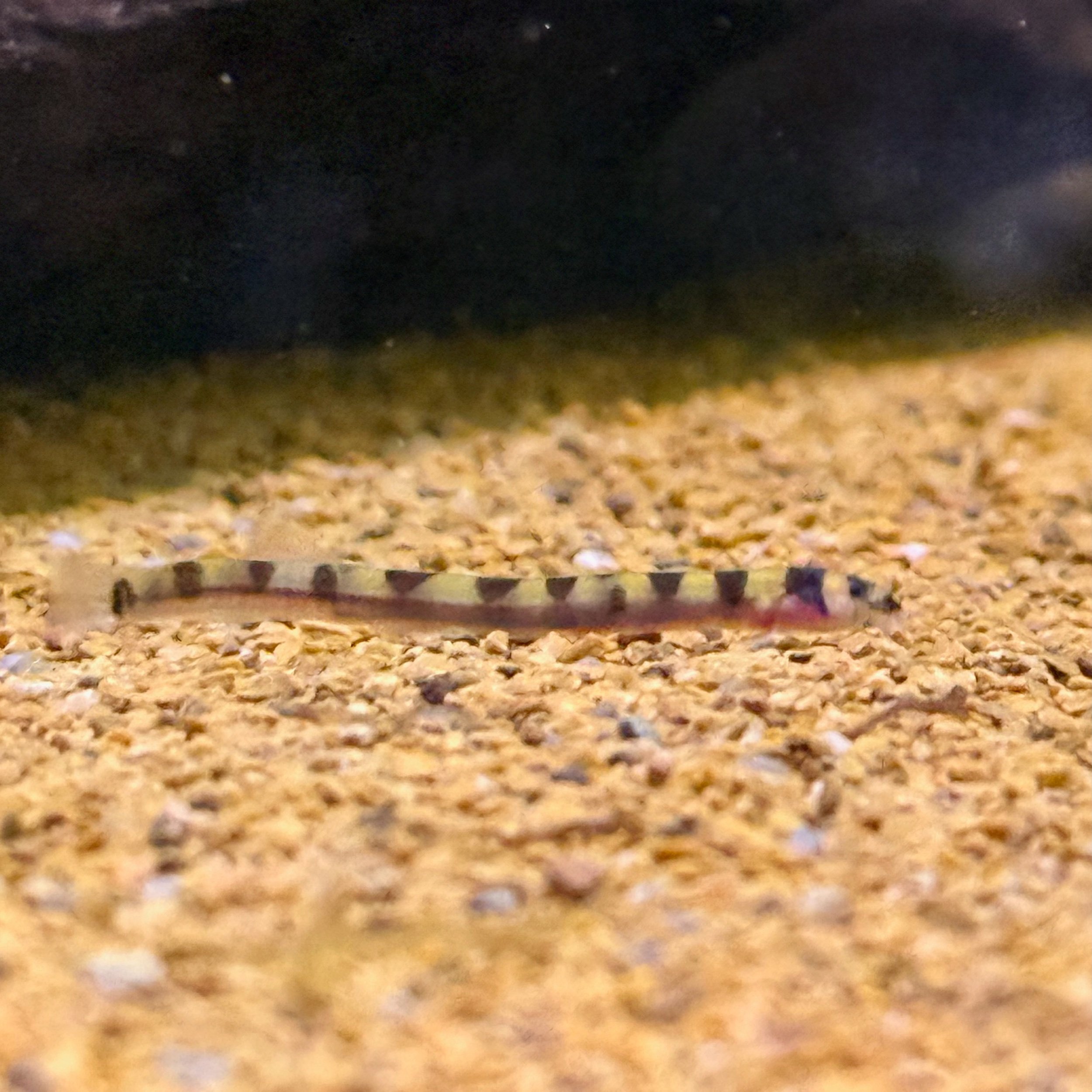 Image 1 of
Image 1 of


Dwarf Chain Loach
The Dwarf Chain Loach, scientifically known as Ambastaia sidthimunki (formerly Yasuhikotakia sidthimunki), is a small and lively freshwater fish that has become a favorite among aquarists for its playful behavior, striking pattern, and suitability for community tanks. Native to the rivers and floodplains of Southeast Asia, particularly in Thailand and Laos, this species is well-suited for well-planted aquariums where it can exhibit its natural schooling behavior.
Physically, the Dwarf Chain Loach is easily recognized by its distinctive chain-like pattern of dark vertical stripes connected by horizontal bars across its silver to golden body. This intricate pattern gives the fish a unique and appealing appearance. The body is elongated and slightly compressed, with a pair of barbels near the mouth that it uses to forage for food along the substrate. Adult Dwarf Chain Loaches typically reach about 2 to 2.5 inches (5 to 6.5 centimeters) in length, making them ideal for smaller to medium-sized aquariums.
In the aquarium, Dwarf Chain Loaches thrive in environments that mimic their natural habitat, which includes soft substrates, plenty of hiding spots, and dense vegetation. They are very social and should be kept in groups of at least six individuals to encourage natural schooling behavior and reduce stress. These loaches are active during the day, often seen darting around the tank or resting together in a tight group. They are peaceful and get along well with other small, non-aggressive fish species, making them an excellent choice for community tanks.
Water parameters for the Dwarf Chain Loach should reflect the conditions of their native Southeast Asian waters. They prefer slightly acidic to neutral water with a pH range of 6.0 to 7.5 and temperatures between 75 to 82°F (24 to 28°C). It’s important to maintain high water quality with regular water changes and efficient filtration, as these fish are sensitive to poor water conditions.
Feeding the Dwarf Chain Loach is relatively straightforward, as they are omnivorous and will accept a variety of foods. They enjoy sinking pellets or wafers designed for bottom-dwelling fish, as well as live or frozen foods such as bloodworms, brine shrimp, and daphnia. They also appreciate small amounts of vegetable matter, such as blanched zucchini or spinach. Providing a varied diet will help ensure their health and vibrant coloration.
Breeding the Dwarf Chain Loach in captivity is challenging and not commonly reported. In the wild, they spawn during the rainy season, and replicating these conditions in an aquarium setting can be difficult. If breeding is successful, the eggs are typically scattered among the substrate or plants, and the fry will need to be fed infusoria or other tiny foods once they hatch. However, due to their small size and the difficulty of breeding in captivity, most Dwarf Chain Loaches available in the hobby are wild-caught or imported from specialized breeders.
Overall, the Dwarf Chain Loach (*Ambastaia sidthimunki*) is a charming and active addition to freshwater aquariums, offering both visual appeal and engaging behavior. Their small size, peaceful nature, and social tendencies make them a great choice for community tanks, where they can thrive and bring life to the lower levels of the aquarium. With proper care and attention to their specific needs, these delightful loaches can become a highlight in any aquarist’s collection.
The Dwarf Chain Loach, scientifically known as Ambastaia sidthimunki (formerly Yasuhikotakia sidthimunki), is a small and lively freshwater fish that has become a favorite among aquarists for its playful behavior, striking pattern, and suitability for community tanks. Native to the rivers and floodplains of Southeast Asia, particularly in Thailand and Laos, this species is well-suited for well-planted aquariums where it can exhibit its natural schooling behavior.
Physically, the Dwarf Chain Loach is easily recognized by its distinctive chain-like pattern of dark vertical stripes connected by horizontal bars across its silver to golden body. This intricate pattern gives the fish a unique and appealing appearance. The body is elongated and slightly compressed, with a pair of barbels near the mouth that it uses to forage for food along the substrate. Adult Dwarf Chain Loaches typically reach about 2 to 2.5 inches (5 to 6.5 centimeters) in length, making them ideal for smaller to medium-sized aquariums.
In the aquarium, Dwarf Chain Loaches thrive in environments that mimic their natural habitat, which includes soft substrates, plenty of hiding spots, and dense vegetation. They are very social and should be kept in groups of at least six individuals to encourage natural schooling behavior and reduce stress. These loaches are active during the day, often seen darting around the tank or resting together in a tight group. They are peaceful and get along well with other small, non-aggressive fish species, making them an excellent choice for community tanks.
Water parameters for the Dwarf Chain Loach should reflect the conditions of their native Southeast Asian waters. They prefer slightly acidic to neutral water with a pH range of 6.0 to 7.5 and temperatures between 75 to 82°F (24 to 28°C). It’s important to maintain high water quality with regular water changes and efficient filtration, as these fish are sensitive to poor water conditions.
Feeding the Dwarf Chain Loach is relatively straightforward, as they are omnivorous and will accept a variety of foods. They enjoy sinking pellets or wafers designed for bottom-dwelling fish, as well as live or frozen foods such as bloodworms, brine shrimp, and daphnia. They also appreciate small amounts of vegetable matter, such as blanched zucchini or spinach. Providing a varied diet will help ensure their health and vibrant coloration.
Breeding the Dwarf Chain Loach in captivity is challenging and not commonly reported. In the wild, they spawn during the rainy season, and replicating these conditions in an aquarium setting can be difficult. If breeding is successful, the eggs are typically scattered among the substrate or plants, and the fry will need to be fed infusoria or other tiny foods once they hatch. However, due to their small size and the difficulty of breeding in captivity, most Dwarf Chain Loaches available in the hobby are wild-caught or imported from specialized breeders.
Overall, the Dwarf Chain Loach (*Ambastaia sidthimunki*) is a charming and active addition to freshwater aquariums, offering both visual appeal and engaging behavior. Their small size, peaceful nature, and social tendencies make them a great choice for community tanks, where they can thrive and bring life to the lower levels of the aquarium. With proper care and attention to their specific needs, these delightful loaches can become a highlight in any aquarist’s collection.
The Dwarf Chain Loach, scientifically known as Ambastaia sidthimunki (formerly Yasuhikotakia sidthimunki), is a small and lively freshwater fish that has become a favorite among aquarists for its playful behavior, striking pattern, and suitability for community tanks. Native to the rivers and floodplains of Southeast Asia, particularly in Thailand and Laos, this species is well-suited for well-planted aquariums where it can exhibit its natural schooling behavior.
Physically, the Dwarf Chain Loach is easily recognized by its distinctive chain-like pattern of dark vertical stripes connected by horizontal bars across its silver to golden body. This intricate pattern gives the fish a unique and appealing appearance. The body is elongated and slightly compressed, with a pair of barbels near the mouth that it uses to forage for food along the substrate. Adult Dwarf Chain Loaches typically reach about 2 to 2.5 inches (5 to 6.5 centimeters) in length, making them ideal for smaller to medium-sized aquariums.
In the aquarium, Dwarf Chain Loaches thrive in environments that mimic their natural habitat, which includes soft substrates, plenty of hiding spots, and dense vegetation. They are very social and should be kept in groups of at least six individuals to encourage natural schooling behavior and reduce stress. These loaches are active during the day, often seen darting around the tank or resting together in a tight group. They are peaceful and get along well with other small, non-aggressive fish species, making them an excellent choice for community tanks.
Water parameters for the Dwarf Chain Loach should reflect the conditions of their native Southeast Asian waters. They prefer slightly acidic to neutral water with a pH range of 6.0 to 7.5 and temperatures between 75 to 82°F (24 to 28°C). It’s important to maintain high water quality with regular water changes and efficient filtration, as these fish are sensitive to poor water conditions.
Feeding the Dwarf Chain Loach is relatively straightforward, as they are omnivorous and will accept a variety of foods. They enjoy sinking pellets or wafers designed for bottom-dwelling fish, as well as live or frozen foods such as bloodworms, brine shrimp, and daphnia. They also appreciate small amounts of vegetable matter, such as blanched zucchini or spinach. Providing a varied diet will help ensure their health and vibrant coloration.
Breeding the Dwarf Chain Loach in captivity is challenging and not commonly reported. In the wild, they spawn during the rainy season, and replicating these conditions in an aquarium setting can be difficult. If breeding is successful, the eggs are typically scattered among the substrate or plants, and the fry will need to be fed infusoria or other tiny foods once they hatch. However, due to their small size and the difficulty of breeding in captivity, most Dwarf Chain Loaches available in the hobby are wild-caught or imported from specialized breeders.
Overall, the Dwarf Chain Loach (*Ambastaia sidthimunki*) is a charming and active addition to freshwater aquariums, offering both visual appeal and engaging behavior. Their small size, peaceful nature, and social tendencies make them a great choice for community tanks, where they can thrive and bring life to the lower levels of the aquarium. With proper care and attention to their specific needs, these delightful loaches can become a highlight in any aquarist’s collection.








